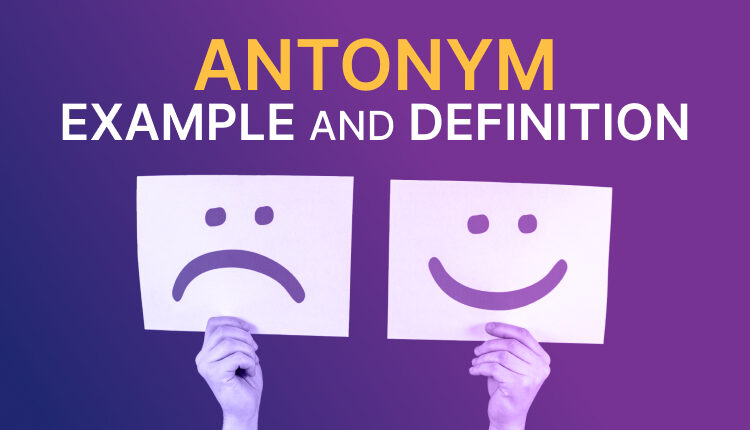Words are the most powerful tools when forming our thought processes and speech. Yet, there’s much more in learning the words. This is one of the excellent things about vocabulary: learning antonyms. These opposing words add richness to our conversations and writing. Learning antonyms helps better express oneself; it also adds richness to one’s understanding of the language itself. Are you ready to plunge into a world of opposites? Let’s dig in and see what antonyms are all about!
What does Antonym Means?
An antonym is a word that expresses a contrasting meaning from another. For instance, “hot” and “cold,” or “happy” and “sad.” These opposites make sense different emotions, states, or conditions within our language.
Examples abound in everyday conversation. If you say someone is “tall,” then an antonym of the same would be “short.” If you say “love,” a similar word to use as its antonym would be “hate.” Understanding antonyms is how we can better put an idea into words effectively and colorfully.
Definition of Antonym
An antonym is a word that has an opposite meaning of another word. For example, when you say “hot” and “cold,” those are two terms that define contrasting temperatures of the same thing. Knowing antonyms extends language and gives us definition and depth of expression.
In communication, antonyms are very essential in helping indicate the kind of precise thought and emotion that one conveys. They enable expressions of differences in ways that have given rise to better nuances in conversations. It can also make your vocabulary better by implying that you have a rich skill in writing.
Examples of Antonyms
Antonyms: These are words that form pairs with opposing meanings. For instance, “hot” and “cold” clearly illustrated opposite temperatures. Other familiar ones would be “big” versus “small,” which illustrate size differences, and “happy” against “sad,” which shows the emotional states.
There are plenty of more examples in contemporary prose. Consider “light” vs. “dark.” You can also think of “fast” and “slow,” which illustrate a difference in speed. These antonyms flavor our words, making expression more graphic and specific. It can present information more persuasively by establishing an idea in a bigger scene.
Importance of Antonyms
Antonyms are actually significant in communication since they help enhance our ability to express contrasting thought. They add depth and clarity, making it possible for us to communicate effectively by bringing, for example, “hot” emotions instead of “cold” ones when trying to paint a picture and trying to make the reader feel it.
It also helps improve vocabulary and facilitates thinking critically about the meaning of words and how they relate to one another. The knowledge thus gained not only contributes words to the vocabulary but also aids creative writing by providing alternatives for varying expression. Accepting antonyms will therefore lead to a more subtle understanding of language itself.
Types of Antonyms
Antonyms can be divided into many different types. One most commonly known type is gradable antonyms, which stand for a spectrum of differences, such as “hot” and “cold.” You can determine a variety of degrees between them, such as warm or cool.
Another variety is that of the complementary antonyms, which forces a choice between two things with no middle alternative like “alive” or “dead.” Relational antonyms are those in which one term implies another exists, such as “parent” and “child.” Each of these varieties adds depth to our understanding of language at the same time as clarity to our communication.
Word History and Origins
The Greek word “antonym” is derived. It is from the word “antōnymon” in which the prefix “anti” means against or opposite, and “onoma” means name. In this etymology lies the very nature of antonyms as opposed words; that is, words that convey opposed meanings.
As languages evolved, so did the use of antonyms in cultures. They are essential articulative devices that help speakers express contrasts vividly. In historical terms, knowing opposites contributed to communication by making it subtler and better at expression through emotion and thought.
Closely related words to antonyms are:
One would discuss synonyms as one of the concepts related to antonyms. Synonyms are words that have a similar meaning. In the case of the previous examples, “happy” and “joyful” were synonyms, and their opposite, or antonym, was “sad.”
Another related concept is homonyms, words that sound the same but have different meanings. Consider “bark,” for example. It can refer to the outer covering of a tree, or to the sound of a dog. Playing with these analogous words sharpens vocabulary and enriches understanding of how we communicate by contrast and analogy.
Quiz Yourself on Antonyms
Ready to test your knowledge on antonyms? Here’s a fun way to see how well you understand this important concept. Try matching words with their opposites, or fill in the blanks in sentences where an antonym fits perfectly.
For example, if I say “hot,” what’s its opposite? Or can you think of an antonym for “happy”? Challenge yourself and friends to see who knows more. It’s a great way to enhance your vocabulary while having some fun along the way!
Conclusion
Understanding antonyms expands your lexicon and further expands your vocabulary to help convey meaning. They provide clarity by establishing contrasts, which shall enable you to speak or write with more precision. The identification of the various types of antonyms might dig deeper into the realization of language nuances.
What better way to enhance vocabulary than engaging with antonyms in daily conversations or writings? This activity brings life to interactions while constantly improving the skills for more appropriate word choices.
Learning more related concepts expands upon linguistic knowledge, and learning is endless with new discovery. You can use this wonderful feature of language as a means of expressing yourself and getting to understand each other better-more in spoken than in written forms.

